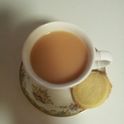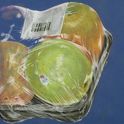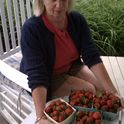Does the five hand-fold technique make a noticeable difference in the outcome of this bread? I'm wondering why not just put it in the stand mixer...
...with the dough hook, like all of the other brioche / challah I make (even Chad Robertson's recipe). With so small a quantity of ingredients, it would be easy, so I'm wondering if the 5 folds are worth the effort.

Recipe question for:
Jessica Fechtor's Five-Fold Challah
7 Comments
AntoniaJamesDecember 12, 2016
Thanks, everyone. Since I had the ingredients out after starting the recipe (I was curious to try the method) and since putting everything into a stand mixer and running it is so easy -- and I had only received one response at that point -- I went ahead and did a side-by-side test. I used Chad Robertson's method from "Tartine Bread" using all of Fechtor's ingredients/ratios.
Let me preface this by saying that I am quite familiar with the folding technique. I've made, I estimate, at least 200 boules, baguettes, batards, etc. of various artisanal breads over the past few years using the folding technique Fechtor describes, which is the method Robertson uses for most breads, but not challah / brioche. I appreciate the benefits, the lovely rhythm, really, of doing chores and other baking or cooking between folds. I make virtually all of the bread our family eats, and the vast majority is made using recipes from Robertson's "Tartine Bread."
Robertson's method for brioche includes waiting about 30 minutes to add the fat, after mixing all of the other ingredients. This gives the gluten time a head start, unhindered by the fat. It's a good idea, so I did that with this dough.
The results: the Fechtor loaf was much more slack, resulting in an irregular shape; the dough was a bit more difficult to work with, but not inconveniently so. The Tartine Bread method produced a luscious light crumb and a perfectly formed braided loaf. Before baking, it was obvious that the gluten structure in the stand mixer loaf was much better. The dough handles beautifully. We love challah buns for certain special meals (poached tuna!) so I divided each batch of dough in two and made up four large buns with each type of dough. Once baked the buns were virtually identical. It was impossible to tell them apart.
All the bread tasted exactly alike.
Bottom line here: I'm really glad I tried this recipe, because it's nice to learn of an easy (relatively speaking) way to make challah without a stand mixer. My son, who is an accomplished artisanal bread maker and does not have a stand mixer, will appreciate this recipe, so I'm glad I gave it a test drive. Do I intend to make it again? Actually, yes - once. The next time we need challah, I plan to use the method, with the intermediate step of waiting 30 minutes to add the oil, to see if that makes a difference. Stay tuned. ;o)
P.S. I also plan to add anise and sesame seeds to the dough, inspired by the Sephardic challah recipe in "Hot Bread Kitchen."
Let me preface this by saying that I am quite familiar with the folding technique. I've made, I estimate, at least 200 boules, baguettes, batards, etc. of various artisanal breads over the past few years using the folding technique Fechtor describes, which is the method Robertson uses for most breads, but not challah / brioche. I appreciate the benefits, the lovely rhythm, really, of doing chores and other baking or cooking between folds. I make virtually all of the bread our family eats, and the vast majority is made using recipes from Robertson's "Tartine Bread."
Robertson's method for brioche includes waiting about 30 minutes to add the fat, after mixing all of the other ingredients. This gives the gluten time a head start, unhindered by the fat. It's a good idea, so I did that with this dough.
The results: the Fechtor loaf was much more slack, resulting in an irregular shape; the dough was a bit more difficult to work with, but not inconveniently so. The Tartine Bread method produced a luscious light crumb and a perfectly formed braided loaf. Before baking, it was obvious that the gluten structure in the stand mixer loaf was much better. The dough handles beautifully. We love challah buns for certain special meals (poached tuna!) so I divided each batch of dough in two and made up four large buns with each type of dough. Once baked the buns were virtually identical. It was impossible to tell them apart.
All the bread tasted exactly alike.
Bottom line here: I'm really glad I tried this recipe, because it's nice to learn of an easy (relatively speaking) way to make challah without a stand mixer. My son, who is an accomplished artisanal bread maker and does not have a stand mixer, will appreciate this recipe, so I'm glad I gave it a test drive. Do I intend to make it again? Actually, yes - once. The next time we need challah, I plan to use the method, with the intermediate step of waiting 30 minutes to add the oil, to see if that makes a difference. Stay tuned. ;o)
P.S. I also plan to add anise and sesame seeds to the dough, inspired by the Sephardic challah recipe in "Hot Bread Kitchen."
TedDecember 10, 2016
I don't know how one would know, unless there's a side-by-side test: one batch in the mixer; one with folds.
I like this recipe and have made it several times. I live in a small apartment with a tiny kitchen-space (less than 20 x 20 inches of countertop) with very little storage space -- so there's no countertop mixer. One of the reasons I like it is because the dough just stays in the bowl. I don't have to clear the countertop (much) to make it. Mix it, set the timer and walk away. Answer emails, watch some youtube videos, write a letter to a friend, do some knitting or spin some yarn, clean the bathroom, reconcile the household budget. Come back and do a fold. Repeat. For me, the folds are neither time-consuming or nor difficult; perhaps my life circumstances are different than for those who do find that. (I don't have kids, for example.)
I like this recipe and have made it several times. I live in a small apartment with a tiny kitchen-space (less than 20 x 20 inches of countertop) with very little storage space -- so there's no countertop mixer. One of the reasons I like it is because the dough just stays in the bowl. I don't have to clear the countertop (much) to make it. Mix it, set the timer and walk away. Answer emails, watch some youtube videos, write a letter to a friend, do some knitting or spin some yarn, clean the bathroom, reconcile the household budget. Come back and do a fold. Repeat. For me, the folds are neither time-consuming or nor difficult; perhaps my life circumstances are different than for those who do find that. (I don't have kids, for example.)
Susan W.December 10, 2016
Yes, I forgot to mention my postage stamp kitchen with one small corner of countertop. I really appreciate that it all happens in one bowl. Fold..take dogs out..Fold...start laundry...Fold..take out recycling. It fits perfectly into a stay at home chore day.
amysarahDecember 10, 2016
I'd be curious to see photos of the folding technique - it seems like it may be one of those recipe that 'reads' as more complicated than it actually is. Pix showing the process is actually easier than kneading could be persuasive for me.
Susan W.December 10, 2016
The directions are spot on. You literally grab an edge, pull to the middle, spin, repeat. So easy.
Susan W.December 10, 2016
I've made this a few times now. I don't own a stand mixer (don't ask about the day the kitchen kid's motor fell into the housing and shocked me..which gave me mixer phobia) and detest kneading, so it's perfect for me.
I also find new techniques to be fascinating and fun to try.
I also find new techniques to be fascinating and fun to try.
mainecook61December 10, 2016
I made it and honestly, I couldn't tell what difference all of that time-consuming folding made, compared to other recipes I have for challah. I often make breads that contain eggs to deal with my oversupply of duck eggs from two prolific Khaki Campbells.
Showing 7 out of 7 Comments
Recommended by Food52
Popular on Food52
Continue After Advertisement



